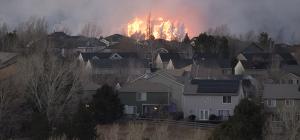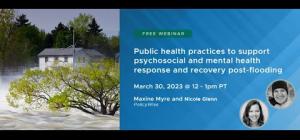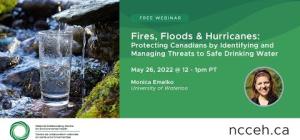
Reflections on supporting community psychosocial well-being after a flood

Helping with childcare. Spending time building trust. Facilitating connections between provinces and local groups. Deploying volunteers to provide psychological first aid. Organizing a knowledge exchange. These are some examples of relationship-based actions that can support psychosocial well-being among flood-affected communities, according to disaster psychosocial recovery professionals and panelists featured in our recent webinar. Their cumulative experience also contributed to two recent reports on the impacts of flooding and how to support psychosocial and mental health recovery:
- Post-flooding community-level psychosocial impacts and priorities in Canada: A preliminary report
- A guide to post-flooding community-level psychosocial response and recovery practices in Canada
In this blog, we summarize our webinar panel discussion in which we dialogued with four disaster recovery professionals about their experiences of supporting mental health and psychosocial recovery across Canada. Additionally, we provide resources to inform post-flooding community psychosocial recovery work.
A summary of the webinar panel discussion
The four discussion panelists (see box) worked closely with flood-affected communities to understand their unique needs and provide supports for mental health and psychosocial recovery. During the webinar panel discussion, they answered several questions from audience members. We summarized the questions and their responses below. A big thank you to the panelists for their time and insights!
| Our discussion panelists: |
|
Can you share examples from your work and from your experience where relationships supported community psychosocial recovery?
Panelists spoke about how trust was a key element for effective provincial support of locally-led recovery. Margaretha shared how during the 2018 flood in Grand Forks, BC, they hired and trained liaison support managers from within the community who had established connections and trust with impacted residents.
“It's really important to develop a network of all these groups that eventually develop trust. […] If you try to skip those steps and just provide resources that you have available, it doesn't necessarily meet the needs expressed by the local community. Ultimately, this also creates a more sustained community action that then can have ongoing supports going forward,” said Graham.
Darlene added that in situations where distrust existed, it was only once her team went door-to-door and got to know people that their information sessions and support groups were well attended.
What are your insights on disaster recovery in situations when one disaster follows another in quick succession?
Panelists noted that psychosocial recovery takes a long time and back-to-back disasters can have a devastating toll on community members. Psychosocial recovery can become prolonged, particularly for people who are evacuated or isolated. Responders are likely exhausted and may experience burnout.
At the same time, communities and local organizations can draw from their experiences, relationships, and the capacity they built during the first disaster to respond to the second. Guy explained that this happened in Fort McMurray with the wildfires in 2016 followed by flooding in 2020. The community already had ideas about what to do and they were able to respond more quickly during the floods.
Funding for disaster recovery is often tied to a specific disaster. With the realities of dealing with multiple disasters at once, something that can be helpful is to incorporate flexibility in funding applications and agreements. Graham noted that “although the scope [of our funding] was to be disaster related, we could then shift the focus to deal with more imminent issues that the community is dealing with.”
How do you ensure you are connecting with those most vulnerable during floods or other crises, specifically people who are unhoused?
Panelists agreed that it can be difficult to consistently share information and connect with groups who are made vulnerable through systemic exclusion and are disproportionately affected by a flood, including people who are unhoused. The ability to connect with diverse groups often depends on the strength of wellness working groups or committees, said Margaretha.
Partnering with agencies who already have connections and relationships to the populations you are trying to support is important to understand community needs and address inequitable impacts. Resources and supports that are by the community for the community are most sustainable. Local agencies can include food banks, shelters, multicultural associations, and other local non-governmental organizations. In some cases, community members can help connect their neighbours with organizations providing psychosocial support. Darlene noted, “We've actually relied a lot on really diligent neighbours. […] Some of it is very organic and grassroots.”
How do you deal with the unknown?
The panelist briefly shared their insights on managing the unknown. Although they were not able to elaborate due to the webinar coming to a close, they did highlight strategies that included sharing knowledge, being dynamic and flexible in your approach, focusing on building trust, and following through on the things you say you will do.
Watch the webinar recording for the full discussion.
Additional resources
The authors thank the webinar attendees who shared the following resources. This is not an exhaustive list, but rather a place to start learning more about how to support psychosocial and mental health recovery post-flooding event.
Community Tool Box
On this website, the Center for Community Health and Development at the University of Kansas provides guidance, tools, and training to grow community building skills.
Emergency Preparedness
On this web page, the Government of Alberta provides information and resources for families to prepare for an emergency or disaster.
Toolkit for Community Safety and Well-being Planning
The Government of Ontario created this toolkit to help municipalities, First Nations, and their partners develop, implement, and evaluate their community safety and well-being plans.
Psychosocial Support in Flooding
In two reports, the International Federation of Red Cross and Red Crescent Societies share actions for supporting psychosocial recovery and resilience in urban areas after a flood.
Mental Health and Wellness Recovery Toolkit (to be updated in summer 2023)
In this toolkit, Health Emergency Management BC provides resources and suggests actions and interventions at various phases after an emergency or disaster to facilitate planning and delivery of psychosocial recovery activities.
Authors
Maxine Myre, PhD, is a Senior Research and Policy Associate with PolicyWise. She leads several projects related to child, family, and community well-being with a focus on community engagement, knowledge mobilization, and health equity.
Nicole Glenn, PhD, is a Research & Policy Manager with PolicyWise where she stewards knowledge mobilization and community-engaged applied public health and social sector research and evaluation. She brings a critical equity lens to all her work.








